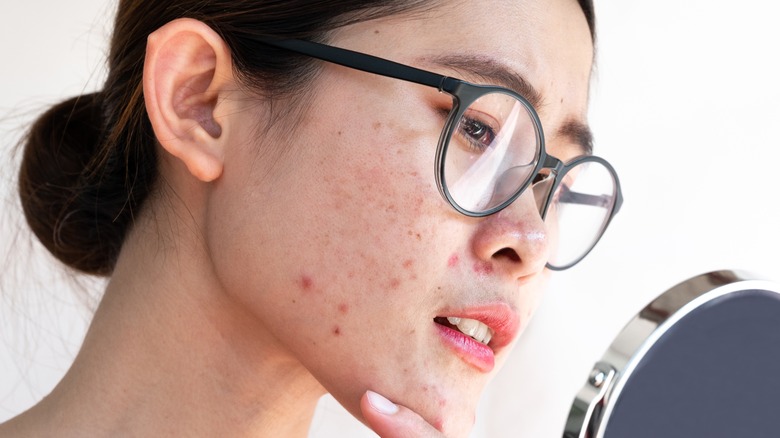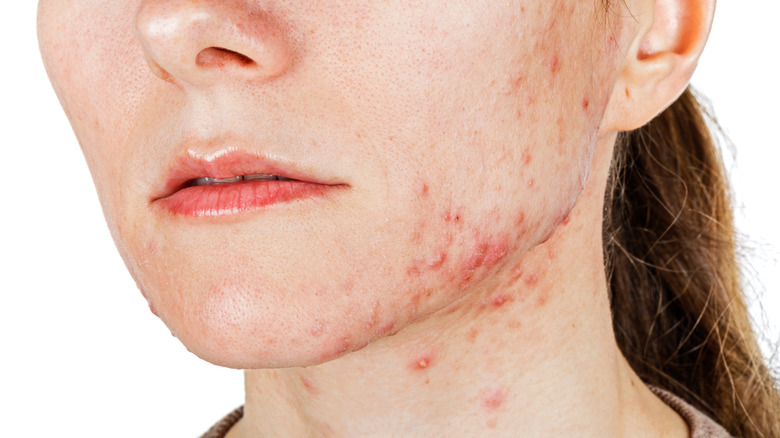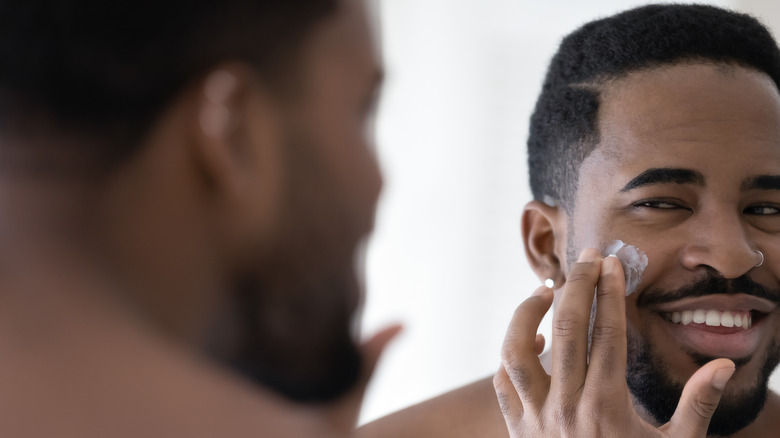All You Need To Know About Blind Pimples
Acne, pimples, and blackheads, oh my! When it comes to your skin, there are numerous types of undesired bumps that can pop up, no pun intended. One type of pimple that you may experience is blind pimples, firm swellings that form just below the skin's surface (via WebMD). Also called cystic acne, blind pimples can be painful and are often sites of inflammation.
Unlike other types of pimples that present on the surface of the skin, such as whiteheads, the occurrence of blind pimples beneath the skin often makes them more difficult to treat. According to the Cleveland Clinic, cystic acne and blind pimples are the most severe type of acne and are more prone to scar than other types of pimples. Because blind pimples occur deeper within the skin, it is important to remember that you should never try to pop them.
Cystic acne is explanatory in its name, as it creates cysts under the skin. The cysts that create blind pimples usually include dead skin cells, oil, and bacteria that culminate in clogged pores beneath the skin's surface (per Cleveland Clinic). When bacteria are introduced into a clogged pore, blind pimples are likely to become inflamed and swollen, thus becoming very painful.
The causes of blind pimples
There are many things that can lead to cystic acne, with certain factors making blind pimples more likely. According to WebMD, two of those factors are genetics and hormones. Family history can play a role in whether or not you are prone to cystic acne. Healthline reports that studies have shown direct genetic links when it comes to blind pimples in adulthood. A person is more likely to experience cystic acne if a sibling, parent, or other first-degree relative has experienced the condition.
Hormones can also prompt blind pimples (via WebMD). Hormones called androgens are known to cause a potential increase in cystic acne because they trigger the skin's oil glands to grow larger, resulting in an increase in sebum production. Androgen levels can increase during puberty, when a woman stops and starts birth control, and throughout pregnancy. While women may be more likely to experience cystic acne because of birth control, menstrual cycles, and pregnancy, androgen increases during puberty affect both females and males.
Even though genetics and hormones can increase the likelihood that a person may experience cystic acne, everyone can potentially experience blind pimples. Because blind pimples form when debris becomes trapped beneath the skin, it's important to wash your face regularly and stick to a hygiene routine. This can prevent oil and dead skin cells from clogging your pores.
How to treat blind pimples
When it comes to treating blind pimples, there are treatments for both individual pimples and the area of skin affected by cystic acne, as well as preventative treatments (per MedicalNewsToday). The best place to start is by developing a regular skincare routine that involves washing your face on a daily basis. Keeping dirt and bacteria off of your face will also keep it out of your pores. Topical washes and creams with salicylic acid and benzoyl peroxide can be purchased at retail stores, and a dermatologist can prescribe ointments with higher concentrations if you feel like over-the-counter options aren't working for you.
Healthline reports that prescription treatments include birth control to mediate hormones, antibiotics that can kill the bacteria trapped within pores, and medications that contain high amounts of vitamin A. Other treatment options available in a doctor's office include light therapy, laser treatment, and chemical peels. When it comes to an especially vicious individual pimple, then cortisone shots can be used to decrease the inflammation and swelling. Your healthcare provider can also drain cysts in-office, but remember: never try to pop a blind pimple on your own!



